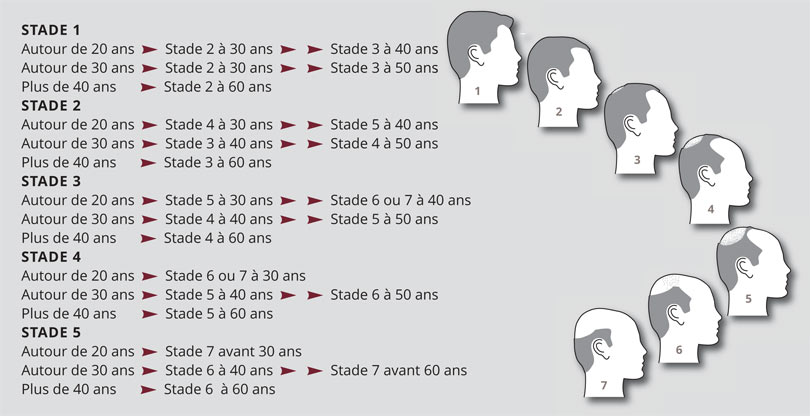Baldness affects a significant proportion of the French population, with a totally unequal distribution between men and women. Baldness affects 70% of men approaching fifty (i.e. around 1 in 3 men), compared with only around 20 % of women. The term "baldness" comes from the Latin "calvus" meaning "bald". In everyday language, the term baldness most often describes a definitive state, irreversible: "we're bald".
Alopecia is the term used to describe hair loss. Androgenetic alopecia, as the name suggests, is a hair loss disorder ("Alopex") whose symptoms are transmitted by genes, and more specifically by "androgens", i.e. male hormones. Hereditary predisposition is therefore entirely justified.
Today, as no genetic manipulation is yet able to treat baldness definitively (fortunately?), it is above all important to find effective treatments to slow down its effects, as these effects are not just purely aesthetic. They can be terribly devastating in terms of self-image and self-confidence, for both women and men.
At Centre Clauderer, we know how to identify the characteristic symptoms of hereditary baldness at any stage and, above all, we can help you combat its consequences. If your baldness is not hereditary, but you're still concerned about your hair loss, we're here to help you too.
What is hereditary baldness or genetic baldness?
Hereditary baldness is the result of androgenetic alopecia. It's the most common cause of hair loss. The causes of this hormonal imbalance, which affects the development of certain hair follicles, lie in our genetic make-up. Hair falls out and is renewed at a faster rate, too fast, and the new hair is finer than the hair it replaces. Hair becomes inexorably thinner as hair cycles are renewed at an exponential rate.
It's important to know that the number of hair follicle cycles (i.e. the number of times the hair follicle will produce a new hair) is limited in time, as if we had hair capital just as we can speak of "sun capital". Unsurprisingly, this ability to renew is determined by heredity. When the maximum number of renewal cycles has been reached, there is no more regrowth possible, which translates into an inevitable progression of increasingly bald areas on the scalp. It has been calculated that we are born with enough hair to theoretically 'last' 100 to 130 years with hair, i.e. 25 hair cycles of around 4 years for men and 4 to 7 years for women.
Causes of hereditary baldness
We now know what causes androgenetic alopecia. Androgenetic baldness is associated with the natural secretion of a male hormone, testosterone, which is locally transformed into dihydrotestosterone. This type of baldness is caused by a genetic sensitivity of the hair follicles to the hormone dihydrotestosterone (DHT). When this hormone comes into contact with the hair follicle, the hair life cycle is immediately disrupted and tends to accelerate until the hair follicle is reduced and inactive.
Heredity: whose fault is it?
Several studies have demonstrated the role of paternal genetic inheritance. The study conducted by Professor Markus Nöthen's teams in 2008 and published in the journal Nature Genetic indicates that a location on chromosome 20 has an effect on the early onset of baldness in men.
But to say that baldness is passed down from father to son is to take a very misleading shortcut. While baldness is in many cases linked to heredity, and men are more affected by androgenetic alopecia than women, hair loss is too complex a phenomenon to stop at this explanation. What's more, every year brings a new batch of discoveries in scientific research into baldness, and it would appear that androgenetic alopecia still has many secrets, particularly as regards the genes involved in the transmission of this imbalance. In fact, fathers, grandfathers, etc. are not the only ones involved, and research recently carried out on a panel of tens of thousands of men (https://journals.plos.org/plosgenetics/article?id=10.1371/journal.pgen.1006594) have shown that :
- there is no single carrier gene but several dozen organised into a vast (and complex) network of genetic markers leading to a genetic predisposition to baldness
- Many of these markers are in fact passed on to men by the X chromosome, the mother's chromosome.
Considered to be the most extensive genetic analysis ever carried out, this study, published in 2017, revealed that 287 groups of genes are linked to baldness.
In short, hair and how it works are still a mystery.
Symptoms of hereditary baldness
To treat hair loss effectively, you need to be able to identify the main symptoms in order to treat, preserve and objectively assess the prospects for development with and without treatment.
Androgenetic alopecia is characterised by a progression through several successive phases.
In men, hair loss, begins at the temples and gradually develops towards the frontal gulfs. Hereditary hair loss then extends to the toupee, i.e. the area above the forehead, before continuing across the entire forehead.

The area at the top of the skull, the tonsure, will gradually recede. Hair loss ends at the whirlpool, i.e. the area at the back of the skull. The hair that resists hereditary baldness generally forms a kind of crown that starts behind the ears and wraps around the back of the skull: this area generally remains intact for life, whatever the degree of baldness achieved elsewhere, and is used as a donor area for hair transplants.
In women, androgenetic alopecia is usually less marked and it is more difficult to identify each phase with certainty. Hair loss commonly occurs on the top of the head, but it is also not uncommon for it to appear in different areas of the scalp. In many cases, hair loss occurs during hormonal upheavals such as pregnancy or the menopause.This is particularly true when oestrogen production slows down.
Non-hereditary baldness: the causes
If you notice abnormal hair loss but do not recognise the symptoms described above, then your hair loss may be due to causes other than the hereditary factor.
Several factors can cause non-hereditary baldness. Acute alopecia, which causes significant and rapid hair loss, can occur after, for example drug therapy or particularly intense stress, but also after a dietary deficiency or illness.
Affecting many men and women, seborrhoeic alopecia takes on the characteristics of androgenetic alopecia. Excessive sebum production makes the scalp particularly thick and suffocates the hair until it falls out.
Presenting itself in the form of alopecia, scarring alopecia affects several areas of the skull. Hair loss is caused by external factors or trauma, such as viral or infectious diseases, fungal infections, metabolic degeneration or external aggression (severe burns, radiodermatitis, etc.).
Other factors can also cause non-hereditary baldness. To make matters worse, some of these factors can actually combine with each other. They can also aggravate hereditary baldness.
Hair loss is quite common with the change of season, in spring and in autumn in particular.
By stimulating the production of androgenic hormones by the adrenal glands, stress due to daily pressure or psychological shock is also responsible for hair loss.
Dietary deficiencies caused by permanent and draconian diets, as well as eating disorders such as anorexia, are also likely to promote baldness.
What is an effective treatment for hereditary baldness?
Drug treatments
Today, two types of drug treatment are used to limit androgenetic alopecia. Minoxidil, although its mechanism of action is not really known, is regularly described as having the effect of prolonging the duration of the hair growth phase (anagen phase), thereby slowing down hair loss and extending the life of the hair. This drug comes in the form of a concentrated solution of 2 or 5 % to be applied to the scalp once or twice a day. The first results are described as "visible" after 4 to 6 weeks of treatment for hereditary baldness.
Marketed under the name Propecia, finasteride, on the other hand, is a drug to be taken orally. This type of treatment limits the harmful effects of testosterone. It maintains hair in 80 % of cases. It even promotes regrowth after 6 months of treatment.
Clauderer serums
Non-medicated, Clauderer serums N°6R, N°7R have been the subject of extensive scientific studies and in vitro tests have demonstrated that they are 3 times more effective than Minoxidil 5% in combating androgenetic hair loss. Clauderer serums combine essential oils, plant extracts and vitamins in optimal proportions, and unlike Minoxidil, do not cause undesirable side effects or addiction.
Mesotherapy and other aesthetic solutions
Mesotherapy aims to revitalise capillary activity. This technique involves injecting polyvitamins into the dermis of the scalp to nourish the hair follicle deep down. Today, more and more aesthetic doctors are training in the injection of PRP or Platelet Rich Plasma to help restore a thicker head of hair.
Micrografting
Micrografting is a surgical solution that aims to restore hair density. Practitioners have developed different grafting techniques: several hair bulbs can be grafted at the same time, or one hair at a time. The aesthetic result and budget will obviously differ depending on the technique used.
Answers to your questions about hereditary baldness
Is baldness hereditary?
Baldness is largely hereditary. It can be inherited from the father's genetic make-up, the mother's genetic make-up or from earlier ancestors (grandparents). Baldness can also be non-hereditary. These include acute alopecia due to fairly intense stress, scarring alopecia affecting several areas of the skull or seborrhoeic alopecia.
How is baldness transmitted?
Hereditary hair loss has always been thought to be passed down from father to son. A hypersensitivity of the hair follicles to the action of a male hormone (testosterone, which transforms locally into dihydrotestosterone) is thought to be the cause of baldness. Recent studies in Scotland, however, have shown that maternal genetic inheritance may also be the cause of androgenetic alopecia.

